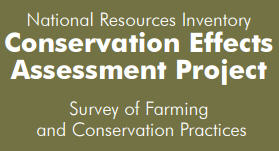
The U.S. Department of Agriculture (USDA) has begun its second nationwide conservation surve y. The 2016 National Resources Inventory – Conservation Effects Assessment Project (NRI-CEAP) survey collects information from farmers and ranchers to more accurately measure the environmental benefits associated with U.S. conservation practices on agricultural land.
y. The 2016 National Resources Inventory – Conservation Effects Assessment Project (NRI-CEAP) survey collects information from farmers and ranchers to more accurately measure the environmental benefits associated with U.S. conservation practices on agricultural land.
Throughout August, U.S. Department of Agriculture National Agricultural Statistics Service (NASS) representatives will ask 25,000 farmers nationwide about production practices including:
- Chemical, fertilizer and manure applications
- Integrated pest management
- Installed conservation practices
- Land and water use decisions
The purpose of the survey is to document on-farm conservation accomplishments, help determine the effectiveness of existing practices, and identify what resources farmers may need to further protect the soil, water and other resources in selected watersheds.
The results of the NRI-CEAP survey will help further develop science-based solutions for improving the environmental quality of agricultural land. Survey results will guide USDA conservation policy and program development and help farmers and ranchers more efficiently and effectively conserve natural resources. For example, a recent CEAP report for the Western Lake Erie Basin shows voluntary efforts are reducing nutrient and sediment loss from farms and that there is opportunity to improve conservation management across the basin. That report informed the development of the new Western Lake Erie Basin Initiative, which helps support farmers’ efforts to improve water quality in the region.
“The survey gives farmers and ranchers the power to provide a more complete and accurate picture of the conservation practices on their operations,” said NASS Administrator Hubert Hamer. “If contacted, I encourage farmers and ranchers to participate. Their collective responses can directly benefit themselves and all producers by helping leaders focus on what producers need to install conservation practices that are best for their operations environmentally and financially.”
The NRI-CEAP survey will be conducted in two parts. In the first survey, which is shorter, NASS will determine eligibility for the more in-depth survey that will take place between October 2016 and February 2017.


